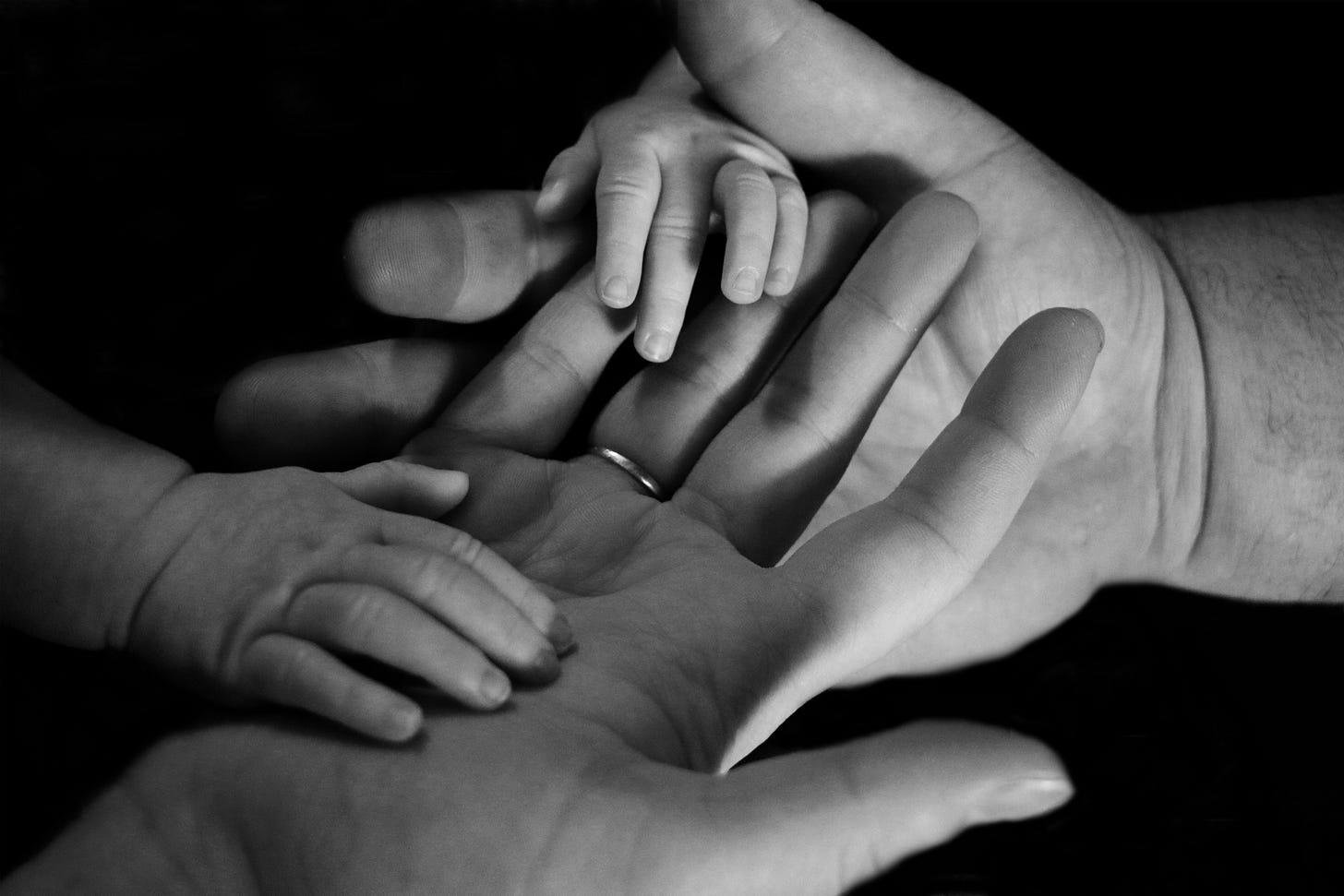"It Ends With Me" - Breaking Generational Cycles of Undiagnosed Neurodivergence
How Inherited Trauma, Late Diagnosis, and Epigenetics are Rewriting our Ancestral Legacy
Have you ever looked at your child and seen your own childhood staring back at you?
Not the sweet moments. The challenging ones. The meltdowns that feel too familiar. The emotional and sensory overwhelm you recognize in your bones. The way they struggle with things that "should be easy" - because you remember struggling with those exact same things.
And suddenly, at 35, 40, 45 years old, you find yourself as a parent, in a room of mirrors. Staring down the barrel of your own undiagnosed neurodivergence while trying to break cycles you're only now beginning to fully understand.
This is the story of how motherhood became my mirror, my deeper awakening, and my chance to rewrite what gets passed down the feminine line of my ancestry.
Part 1: The Inheritance - What Lives in Our Cells
Trauma doesn’t live only in memory - it can also affect how our bodies switch genes on and off.
When my grandmother was a young girl growing up in communist Bulgaria, surviving meant being silent and invisible. Don't ask too many questions. Don't be too loud. Don't draw attention to yourself. Her heightened sensitivity - what we might now recognize as sensory processing differences - was something to hide rather than honor.
She passed down this survival strategy to my mother, who perfected the art of masking long before anyone even had a name for it. My mother mastered the art of performing neurotypicality so well that in the end, even she believed the illusion.
By the time I came along, the pattern was already deeply embedded: be obedient, smaller, quieter, more acceptable. Survive by becoming who they need you to be.
Here’s what epigenetics teaches us: Those survival strategies our ancestors used? They’re more than learned behaviors. They can shape how genes are expressed.
The Dutch Hunger Winter (1944–1945) taught us something profound: when pregnant women endured famine, the babies in their wombs carried lasting biological imprints into adulthood. Decades later, those children showed changes tied to how metabolism- and stress-related genes switch on and off - epigenetic marks shaped by that early scarcity. In some studies, echoes of these effects also appeared in their children. It’s a human reminder that what a mother’s body survives can leave footprints that reach beyond memory, into how life itself is regulated.
Our nervous systems carry the memory of dangers our great-grandmothers faced. The hypervigilance. The people-pleasing. The constant scanning for threats. What helped them survive became the very patterns that continue to keep us trapped.
But here's the beautiful part: epigenetics works both ways. Just as trauma can be inherited, so can healing. When we change our patterns, we influence what gets passed down.
Part 2: The Great Awakening - When Motherhood Reveals Everything
I lost myself twice in the span of two years.
First, when I became a mother. The Maiden archetype - the independent, achieving, prove-myself-worthy woman I'd spent decades perfecting - died the moment my daughter was born. I grieved her like a death because it was one.
Then, watching my daughter struggle with the same invisible battles I'd fought my entire life, I lost myself once more. This time, it was the neurotypical identity I quietly doubted, yet never dared to question.
The threshold of motherhood is a revealer of truth. Suddenly, you're responsible for another nervous system while your own is more dysregulated than ever postpartum. You're trying to meet needs you never truly learned to recognize in yourself - ignoring yours was so much easier. You're advocating for a child who reminds you of everything you were never allowed to be.
When my daughter had her first meltdown in the middle of a crowded shopping mall, it wasn’t only her overwhelm that hit me. I felt the phantom pain of every single time I was scolded for being "too sensitive" as a child and for overreacting. Every time I'd been told to "just get it together" when the world felt like too much.
It felt like death and liberation all at once.
It would take another year of doubts and questioning until I found out I wasn't crippled. I was neurodivergent. And so was she. And probably my mother. And likely my grandmother before her.
But I was the first to be given the words to finally name it.
Part 3: The Parallel Journey - Healing While Parenting
How do you give your child what you never received when you're still grieving not having it yourself?
This is the impossible logic of conscious parenting as a late-diagnosed neurodivergent woman. You're learning to validate your daughter's sensory needs while still processing the trauma of having your own dismissed. You're teaching her emotional regulation skills you're developing from scratch. You're breaking patterns you're only now fully beginning to recognize.
Some days, I watch my daughter stim loudly and freely and feel pure joy for her freedom. Other days, I watch her and feel the abandonment and rejection for the little girl I once was, who learned to stuff it all down and “behave”.
The mother-daughter mirror is relentless. When she struggles with executive function, I get a flashback of every moment I was being disciplined. When she has trouble with social cues, I remember the crushing loneliness of constantly feeling awkward and never quite fitting in.
But here's what I'm learning: my healing and her thriving don't have to happen separately. We're doing this work together, in real time. When I learn to meet my own sensory needs, she sees that it's safe to meet hers. When I practice self-compassion for my AuDHD brain, she learns that neurodivergence isn't something to fix, but to honor.
We're both learning what it means to be authentically ourselves instead of performing for acceptance and belonging.
The feminine ancestral line in my family has been one of beautiful, brilliant, but also relentlessly self-militant women who learned to make themselves smaller to survive. My daughter gets to be the first one who doesn't have to shrink from her greatness.
Part 4: Breaking the Chain - Creating New Neural Pathways
"It ends with me" isn't an affirmation. It's a daily practice. And a humbling one.
Every time I validate my daughter's experience instead of dismissing it, I'm helping create new neural pathways - for both of us. Every time I model self-advocacy instead of people-pleasing, I'm interrupting generations of learned submission and exploitation.
The science backs this up: neuroplasticity means our brains can rewire throughout our lifetime. Each time we choose a different response, we strengthen new pathways - patterns our children can experience and internalize.
But breaking generational cycles isn't pretty. It's messy, chaotic, painful work that happens in shopping mall meltdowns and rabid bedtime struggles and moments when you realize you're parenting from your own unhealed wounds.
Some days, I fail spectacularly. I react from my trauma instead of responding from my wisdom. I project my own childhood pain onto her present experience. I catch myself trying to fix her instead of simply seeing her for who she really is.
And then I repair. I acknowledge my mistakes. I model how to come back to connection after disconnection. Because that's the work too - showing her that relationships can survive rupture, that disagreements don't mean abandonment, that love doesn't require perfection.
The feminine ancestral line in my family is being rewritten in real time. Not just for my daughter, but backwards through time. Every pattern I heal, every cycle I break, every moment I choose consciousness over conditioning - it ripples through the entire lineage.
The Legacy We're Co-Creating
My deepest wish and commitment is that my daughter will never know the particular pain of spending decades wondering what's “wrong” with her. She'll grow up knowing that her brain works differently, not difunctionally. She'll understand that sensitivity can be a superpower, rather than a weakness. She'll learn to stand up for her needs instead of pulling them under the rug, then crying into the pillow in silence.
But more than that, she'll carry the cellular memory of being truly seen and accepted. Her nervous system will remember safety instead of survival. Her children - if she chooses to have them - will inherit resilience instead of trauma.
This is how ancestral healing works. Not through perfect parenting or having it all “figured out”, but through the willingness to show up and continue to do our own work while raising the next generation. Through breaking our own patterns while teaching our children they never needed to have them in the first place.
There’s another truth we sometimes forget: biology is not destiny. Epigenetic marks and neural pathways are responsive - they shift with safety, nourishment, repair, and time. When our descendants grow up in steadier environments, stress patterns can finally soften. When we change the air our children breathe - both emotionally and physiologically - we help their bodies write a new story for all of us.
It ends with me. And it becomes her new beginning.
Gentle reminder: The Purple Spectrum is educational, not medical advice, diagnosis, or individualized treatment. Reading this doesn't create a clinician-patient relationship. Bodies vary—reference ranges, medication responses, and supplement safety are individual. Please discuss all labs, medications, hormones (including HRT/MHT), and supplements with a qualified clinician who knows your history, especially during major transitions like puberty, pregnancy, postpartum, and perimenopause. If symptoms are severe, worsening, or you're in crisis, seek urgent or emergency care in your region.










Inheritance is the unshed tears of grandmothers that ferment in our bones. To break cycles is to sit in the rawness of rupture and still choose not to repeat. Perhaps, your daughter’s meltdowns are the rebellion your lineage prayed for in secret. Every time we refuse to shrink, the past unclenches its grip. What they called dysfunction is the root of our future strength.